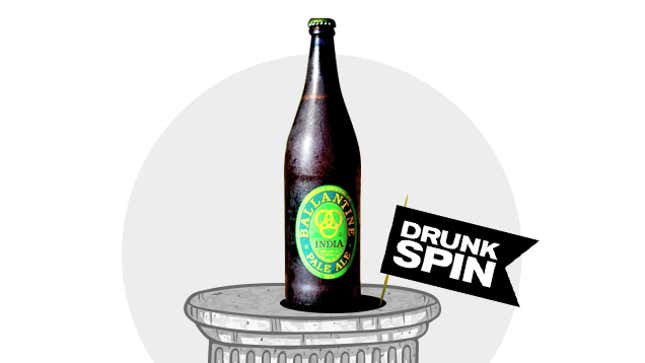
India pale ale is far and away America's favorite style of craft beer (at least during the handful of months when there isn't pumpkin juice all over the goddamn place), which is why it made sense for Pabst Brewing to announce late this summer that they were resurrecting Ballantine IPA.
The Ballantine brand has been awfully quiet for the past few decades, though you can still find a low-end, contract-brewed, lager-like snoozer called Ballantine XXX Ale if you're hell-bent on looking for that kind of trouble. But way back in the day, when American beer was good the first time around—before it went to shit for a half-century or so—an outfit called P. Ballantine and Sons was a legitimate, independent brewery in Newark, NJ, and in 1878 they began producing an IPA that is now generally regarded as America's first version of the British-born style of hoppy pale ale.
Back to Pabst: About a month after they decided to recreate America's first IPA, they decided to become America's first beer company to be sold by a snack-cake mogul to a Russian beverage company. Pabst has long been more a holder of trademarks and a maker of deals than a brewer of beer; consequently, a guy the New York Times describes as a "consumer products magnate" bought the company in 2010 for $250 million. Then he bought Twinkies from Hostess. Then he sold Pabst to Russia's Oasis Beverages for around $700 million.
I don't know what this will ultimately mean for the individual brands in the Pabst portfolio. Best-case scenario, they get spun back off into independent companies with honest brewing intentions, as happened several years ago when Narragansett made a triumphant return from Pabst limbo.* Rather than speculate on the future, let us just note that this Twinkie King's kids, who ran the company until a few weeks ago, had the decency to green-light the Ballantine IPA experiment before they moved on to whatever Twinkie princes do after their dad consummates a nine-figure beer deal. Nap, one suspects, or sail.
Back to beer: The original Ballantine IPA recipe is long gone, which makes this at least something of a marketing stunt, but word on Beer Street is that whoever oversaw the rebirth at Minnesota's Cold Spring Brewery made a good-faith effort to match the original formula. I can confidently report only that this iteration of Ballantine IPA is a pretty good beer.
It pours a nice burnished bronze with a thin khaki head. The aroma is impressively balanced—I was expecting it to be done in the more traditionally malty British style, but the toffee notes are matched by plenty of multidimensional hops that showcase flowers, pine resin, and mixed citrus. The malt turns biscuity when you actually drink it, drier than suggested by the first impression, as the hop character grows even more prominent as things open up. Ballantine IPA is a complex beer, with distinct orange and grapefruit flavors mingling with caramel malt and a light hint of vanilla that likely comes from an oak-chip immersion (the original was aged in oak barrels; the new one isn't, but there still seems to be some wood influence).
If you're interested in the history of American brewing and can overlook the inconvenient facts relating to this beer's tortured path from 1878 Newark to 2014 Moscow, a 22-ouncer of 7.2-percent-ABV Ballantine IPA is certainly worth a one-time outlay of $7.
* A h/t to beer writer Jason Notte for the last-minute education; we stumbled into a conversation about this right after I wrote a first draft that didn't acknowledge the possibility that some Pabst-held legacy brands could see their fortunes improve with this deal.
This is Drunkspin Daily, the Concourse's adequate source for booze news, reviews, and bullshit. We'll be highlighting a beer a day in this space; please leave suggestions below.
Will Gordon loves life and tolerates dissent. He lives in Cambridge, Mass., and has visited all of the other New England states, including, come to think of it, Vermont. Find him on Twitter@WillGordonAgain. Image by Jim Cooke.
The Concourse is Deadspin's home for culture/food/whatever coverage. Follow us on Twitter.